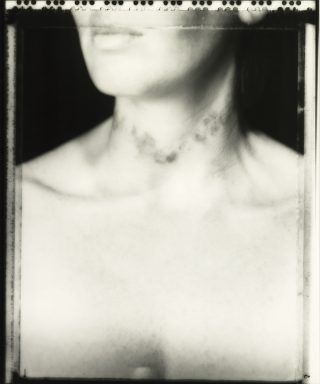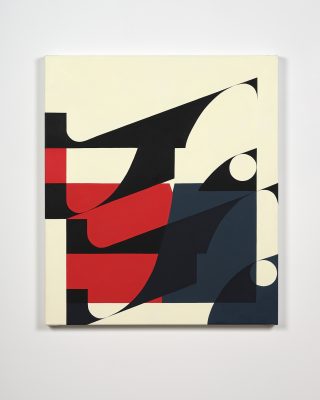For several months now, I’ve been living with an orchid. The relationship was arranged, and unanticipated. The plant turned up one day, an apology gift for my partner from a friend, and immediately became a source of anxiety for me. I’ve no green thumb—I can cause the demise of the least fussy of plants—and I’ve a particularly acute fear of destroying the beautiful: the panic of the art writer. When the orchid lost its flowers, I couldn’t help but take it personally, though I understand that such things happen. Each withering bloom seemed a judgment. My partner lopped off the dead stem. The body remains on the kitchen bench, leaves wrinkling sporadically in quiet discontent.
*
Scrolling through Instagram of an afternoon, my eye snags on a painting of a flower by Sharnaé Beardsley. It’s an orchid, though that isn’t immediately obvious, because the artist has engaged in a measure of stylisation, creating a sort of mannerist portrait. Her modifications are not outlandish. Where previous works have seen Beardsley twin blooms, pattern-tangling their stems like Celtic or nautical knots, here she’s plumped for greater subtlety. She’s exaggerated existing forms, pumped up the colour. I’m reminded rather of that old schoolroom experiment. Pop your freesias in dye and watch them acquire the blues.

Sharnaé Beardsley, Orchidelirium 11, 2019. Image courtesy of the artist and The National, Ōtautahi Christchurch.
I wonder if Beardsley means to hint at more insidious experiments, this floral shapeshifter standing in for less elegant Frankenstein’s monsters: crops manipulated to make them resistant to Roundup, say, allowing the pesticide pedlars to ramp up their commerce (never mind that the product peddled might be carcinogenic). The artist sends me a magazine clipping of a quartet of ‘older gentlemen’, all white. They’re ostensibly scrutinising a prize-winning orchid, like a dog at a show. The image recalls of the foundations of genetic engineering in cross-pollination and selective breeding. How long we’ve moulded organisms to our needs, to satisfy our appetite both for food and for the fantastic.
I think also of the science-colonial impulse. The will to uncover the secrets of the botanical world, because plants pay dividends (yielding cloth, for instance, relieving pain), and the will to control it, by collecting samples, ordering them, labelling them with quintessentially western Latinate names. Equally, of course, there’s bliss in knowledge. I remember the first time I saw Banks’ Florilegium, a compendium of copperplate engravings of botanical specimens collected during the voyages of James Cook, printed in colour some two centuries late. I had not previously been aware of the orchids native to Aotearoa, but there they were among the folios: tiny and delicate-looking, perfect and shy.
Beardsley’s orchid is not shy. It’s a performer, exceeding the bounds of its white stage. There’s something mischievous about the flower, as if it’s trying on new identities, turning the tables to mock an insect mocking a bloom. Orchids of roughly the same hue exist, including in Aotearoa, but this particular bloom strikes me as akin to a drag queen trying on an iris costume, seeing how it feels to wear imperial purple for the evening. I think of the iris in art history. Its recent use by Dane Mitchell. Its function as a figure for the blue-cloaked Virgin—as, for instance, in Hugo van der Goes’s Portinari Altarpiece from the 15th century. Immaculate mimicry.
Other historical images ghost Beardsley’s work. Pictures from early herbals and compendia. The painstakingly rendered arrangements of botanical artists working in Aotearoa, so many of whom have been women: Fanny Osborne, Georgina Hetley, Emily Harris, Sarah Featon, Audrey Eagle. There are echoes, too, of modernist masterpieces, such as the Japanese-flavoured watercolours of Rita Angus and the bodily blooms of Georgia O’Keeffe. One could go on. And that’s significant. Beardsley is far from alone in her fascination with flowers. She’s one in a legion in time—including the Sunday painters, the apothecaries, the tulipomaniacs, and, naturally, the ‘orchidelirious’.
*
I minister to the orchid on my kitchen bench. I make plans to buy it a new pot, to displace the awful tawdriness of the plastic container it came in. I investigate tricks to trigger reblooming, buy the requisite fertiliser, test out a few positions within the apartment. I hanker for the day the new flowers begin to appear and wonder at the process. Will they emerge with their blazing magenta markings already formed? Or will these develop later, deepening over time like accretions of pigment on a fleshy piece of paper? Time will tell. One simply has to be patient, and pay a close eye.
*
Essay commissioned by Sharnaé Beardsley to accompany the exhibition Orchidelirium.
Orchidelirium
Sharnaé Beardsley
18 June to 6 July 2019
The National
Ōtautahi Christchurch



